 |
 |
 |
In this issue:
1- Seasons greetings
2- Be a part of Nubia rescuers
3- Nubians need reparations from Italy
4- Time is running short for sites to be nominated to WMF Watch
5- Baby Museums in Nub
6- Nubians need reparations from Italy |
|
|
|
Time is running short for sites nominations to WMF Watch
The deadline for nominating sites for the World Monuments Fund Watch is approaching and the Nubians and Sudanese academicians are not heeding to our contineous calls to move quickly and nominate some of the threatened Nubian sites such as the historic islands of Sai and Soleb or the last Christian sites at Soba soyj of Khartoum.
BABY MUSEUMS IN NUBIA
Nubia Project made an appeal during the 11th and 12th International Conferences of the Nubian Society convened in Viena and London respectively to encourage the international museums hosting Nubian artifacts to sponsor baby museums in Nubia. This will invite international tourism to Nubia and save Nubia from destruction by dams and vandalism. We call upon UNESCO to adopt this appeal with the help of MO Ibrahim Foundation
.
|
 |
|
Seasons Greetings
|
Merry Christmas and Happy New Year to all.
It gives us great pleasure to share the with you seasons greetings and wish you all a Merry Christmas and a Happy New Year.
 & &  |
|
|
BE A PART OF NUBIA RESCUERS
Your tax deductible donation will help stop destruction of Nubia and its monuments by dams. Nubia is also threatened by the recent rush of gold seekers who began to vandalize historical sites, loot and smuggle historical treasures, beside destroying the environment and Arabization.
You can help us also by spreading the word to your friends and by contacting your US Congress representative, Parliamentarians and decision makers to exert pressures on Sudan government, China and Arab financiers to stop damming Nubia.
If we do not move quickly then Nubia will be gone for ever! Your silence will help in destroying Nubia. Do not be a part in destroying Nubia by your silence but make the history by being a part of the rescuers of an international heritage you proudly relate to, and never allow the fanatics who are calling now for the destruction of the pyramids distract your attention or drag the world to the ages of darkness.
It is your turn to make the change by safeguarding the fabric of your heritage, your past, your present and your future perfectly knitted and intact.
 |
Italy! Nubians Need Reparations for their looted treasures!
The Destruction of Pyramid N 6 of the kandake (ruling queen) Amanishakheto
The number of pyramids in ancient Nubia (aka Kush & today Sudan) were a total of 223, (Kerma, Napata, Nuri, Naga, and Meroe), double the pyramids of its neighbor Egypt. The underground graves of the Nubian pyramids were richly decorated. All pyramids were not monuments of kings is evinced by their great number. Other grandees of the empire, especially priests of high rank, or such as had obtained the sacerdotal dignity, might have found in them their final resting place. The well-known British writer Basil Davidson described Meroe as one of the largest archeological sites in the world.
Almost all the royal tombs in the necropoli of Kurru, Gebel Barkal, and Meroe were thoroughly plundered. Those few objects that have survived—forgotten, lost, or thrown aside by the tomb robbers—provide a dull reflection of the original splendor of the tomb furnishings. One exception, however, is Pyramid N 6 of the kandake (ruling queen) Amanishakheto in the northern cemetery of Meroe.
Like many other pyramids there, it was still well-preserved at the beginning of the nineteenth century, as is shown here (left) by Frederic Cailliaud's drawing of 1822.
Only twelve years later, it had become a mere pile of stones. The Italian physician Giuseppe Ferlini, who had come to the Sudan with Muhammad All's troops, leveled it, as well as many other pyramids, in the search for treasure. An apparently undisturbed golden treasure came to light, which Ferlini immediately hustled out of the country. In a catalogue published in Italian in Bologna in 1837, followed by a French edition published in Rome in 1838. He introduced his treasure to the world and invited buyers.
In 1839 a portion of the finds was acquired by the royal Bavarian art collections; the remaining portion proved difficult to sell, probably because of the unusual style of the jewelry, which cast doubt on the authenticity of the find. This doubt was only removed a decade after Ferlini's discovery, when Richard Lepsius, who in 1842 had recommended acquisition for the Berlin Egyptian Museum, arrived at Meroe. He reports in his correspondence: "Several pyramids have been completely destroyed, others only partially. None had its top preserved. Our kavass, who was here with Ferlini, showed us the spot beneath a now leveled pyramid where he supposedly found his golden treasure." Lepsius continues: "Osman Bey (who camped with
his troops in the vicinity) wanted to make treasure hunters out of his pioneers, and ordered his battalions here in order to rip a number of pyramids apart. Ferlini's discovery sticks in everyone's mind here and has since brought several pyramids to ruin . . . I was able to dissuade him from this idea and so for now at least the few remaining pyramids saved. The soldiers have left, without declaring war on the pyramids" (R. Lepsius, Briefe aus Aegypten Aethiopien und der Halbinsel Sinai, [Berlin, 1852, p. 206). The remaining portion of Ferlini's treasure was purchased for Berlin at Lepsius's recommendation in 1844.
The quality of craftsmanship of the jewelry cannot be compared with the work of Hellenistic goldsmiths. The unique significance of the find lies in the combination of Egyptian, Meroitic, and isolated Hellenistic elements into an original composition. The rich iconography of the shield and seal rings, armlets and necklace significantly expands the repertoire of relief's from Meroitic temples and the offering chapels of Meroitic pyramids. They also provide the original evidence of royal costume as represented in the relief's.
Reference:
Sudan: Ancient Kingdoms of the Nile,1997. Dietrich Wildung, p. 302
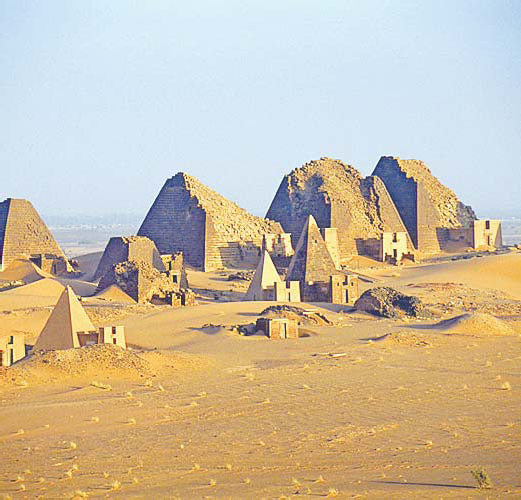 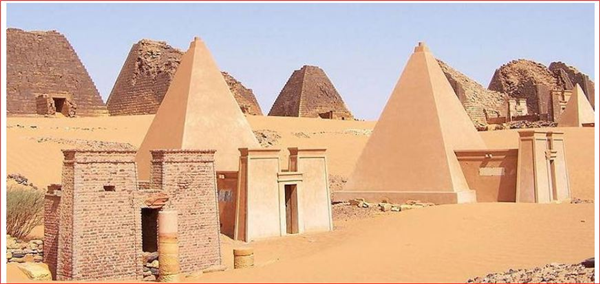
These pyramids in northern Sudan were built from the 4th century BC to 3d century AD. They belong to Nubian kings.
Jewelaries of Queen (Kandake) Amanishakito stolen by The Italian physician Giuseppe Ferlini
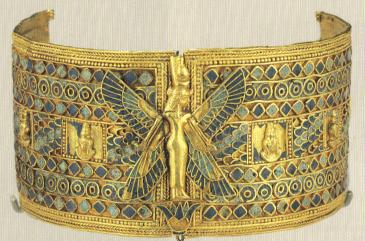 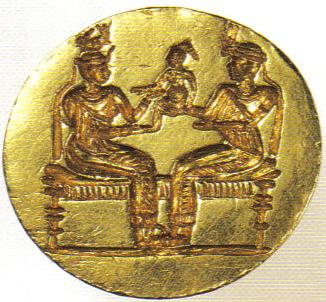
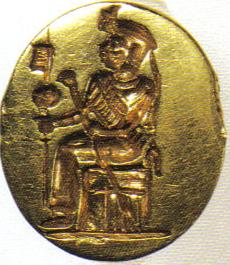 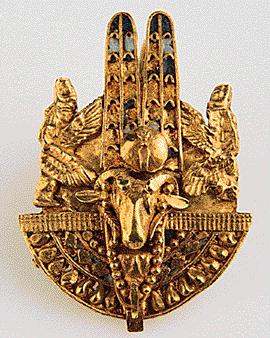
|